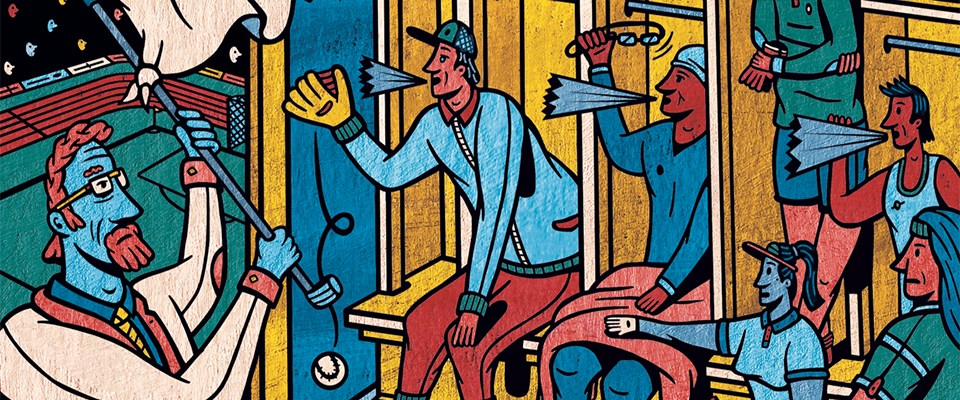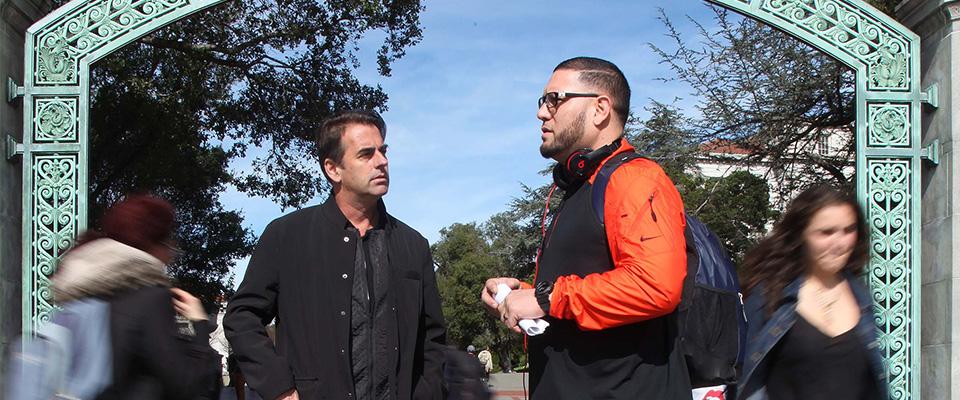And vice versa
The rumpus was loud around the playing fields inside the cavernous San Francisco Concourse. Athletes and dancers bent and stretched, slapping each others’ backs and muttering encouragement to themselves; students in the Straw Marching Band’s array of bashed-up boaters and tattered vests bleated and blared a series of ferocious fight songs; young members of the Oberlin Dance Collective Dance Jam, spiffy in red and black satin, jumped, turned, and cheered. The games hadn’t begun, but the warm-up for Toe to Toe: The Rematch! was already hot.
The second annual Toe to Toe last February pit Cal athletes against performers from the Oberlin Dance Collective and several other troupes in a series of tests comparing skills of stage and stadium. In 2007, the first year, the dancers had clobbered the athletes. This year, the students were psyched for revenge. Could they come back? I asked Harris Barton, a former 49er and one of a roster of celebrity judges that included athletes and dancers. “Not a chance,” he said.
The event is an experiment cooked up by Warren Hellman ’55 and his pal ODC founder Brenda Way, to test ballet-lover Hellman’s theory that performers are as tough as athletes. It’s also, says Hellman, a fundraiser that nets “a good deal of moolah” for the dance company and for Cal Athletics.
The swarming crowd pressed around, and suddenly the games were on, in a test of speed and agility; then moving to the ring, where endurance, balance, and strength were measured; and finally to the stage, where performers and athletes danced together in pieces choreographed by Way.
Competitors in five races—including three-legged and wheelbarrow—barreled down the lanes, fans of both sides yelling them on. The students were fast, but the dancers, flipping, somersaulting, spinning, were like flashing butterflies, and what’s more, perfectly coordinated when pair action was required. They started to rack up points.
Next, the crowd surged to surround a raised ring, spotlights shining down. In Balance and Bling, contestants in opposite corners balanced on one foot while donning items of clothing hurled by teammates. Again, dancers juiced up their movements with sideways splits and lifts. In Table for Four, competing quartets bent over backward at the knees to form human coffee tables that rotated while maintaining formation. Picture a sideways wheel made of interlocked torsos. The movements were painstaking; sweat poured down the competitors’ faces.
Finally, the last event was on, a cooperative dance onstage to The Contours’ “Now That I Can Dance.” Five women from the soccer and track and field teams, paired up with ODC partners. They wore flirty summer dresses, and by the time the song was two familiar measures in—”Do you really love me?”—they were whirling, shimmying, and swaying, while most in the audience shook their shoulders to the beat.
A dance to The Beatles’ “Help” featured football giants Alex Mack and Mike Tepper tossing around the dancers, like bears with bees. Yes, the choreographed steps looked similar to football warm-up moves, but no matter. Rock ‘n’ roll packs enough punch to make exercise look euphoric. “You were dancers,” judge Joanna Berman, a former San Francisco Ballet star, told them after the performance. “You weren’t athletes trying to be dancers.”
Amy Bair, director of Student Athletic Development, recruited 30 athletes from women’s tennis, soccer, and gymnastics teams, and men’s gymnastics and football teams for the Rematch. The invitations pictured Mack cavorting with Tinkerbell-size dancers Annie Zivolich and Quilet Rarang, “It took me three days to convince him to be my poster boy and three months to convince him to dance,” Bair said.
In the end, dancers won again (240–211), proving Hellman’s contention: Every dancer is an athlete. Athletes said they’d learned about grace and the benefits of continual stretches, practical techniques they could apply to sports. There were other lessons, too. “As a youngster I didn’t even go to parties,” said Bernard Hicks, a football player who danced in 2007. “You ought to see me now. I’m a dancing man.”





















